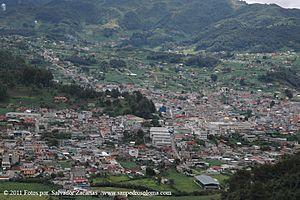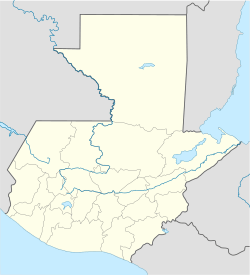San Pedro Soloma facts for kids
Quick facts for kids
San Pedro Soloma
Tzu'luma
|
|
|---|---|
|
Municipality
|
|

San Pedro Soloma "El Valle del Ensueño"
|
|
| Nickname(s):
El Valle del Ensueño
|
|
| Country | |
| Department | |
| Municipality | San Pedro Soloma |
| Government | |
| • Type | Municipal |
| Area | |
| • Municipality | 264 km2 (102 sq mi) |
| • Land | 266 km2 (103 sq mi) |
| Elevation | 2,300 m (7,500 ft) |
| Highest elevation | 3,500 m (11,500 ft) |
| Lowest elevation | 1,900 m (6,200 ft) |
| Population
(Census 2018)
|
|
| • Municipality | 49,030 |
| • Density | 185.7/km2 (481.0/sq mi) |
| • Urban | 14,166 |
| • Ethnicities | Q'anjob'al Ladino |
| • Religions | Roman Catholicism Evangelicalism Maya |
| Time zone | UTC-6 |
| Climate | Cwb |
| Website | Site |
San Pedro Soloma is a town and area in Huehuetenango, Guatemala. Its Mayan name is Tzu'luma, which comes from the Qʼanjobʼal people. The town is found in the Sierra de los Cuchumatanes mountains. It sits high up, about 2,300 meters (7,546 feet) above sea level.
The whole area of San Pedro Soloma covers about 264 square kilometers (102 square miles). The land goes from 1,900 meters (6,234 feet) to 3,500 meters (11,483 feet) high. Around 49,030 people live here. They are spread out in the main town of Soloma, 19 villages, and 50 smaller communities.
Every year, the town celebrates its patron Saint Peter. These special celebrations happen from June 24 to June 30.
Contents
History of San Pedro Soloma
Early Spanish Influence
After the Spanish conquest of Guatemala in the 1520s, Spanish religious groups came to the area. One of these groups was the "Order of the Blessed Virgin Mary of Mercy," also known as the Mercedarians. In 1565, they formed a special area called the "Presentación de Guatemala" Mercedarian province.
At first, the Mercedarians had churches and teachings in areas closer to the capital city. But they traded these with another group, the Order of Preachers. In return, the Mercedarians received control over areas in the Sierra de los Cuchumatanes mountains, which included San Pedro Soloma.
Mercedarian Teachings and Changes
During the early 1600s, the Mercedarians also had churches in four towns near the capital. These towns later became parts of the city. Their main center was in San Anton, where their leader lived.
Records from 1613 and 1770 show that the Mercedarians managed nine main areas for teaching. They also had many smaller connected communities. Some of these areas included:
- Santa Ana de Malacatán
- Concepción de Huehuetenango
- San Pedro de Solomá
- Nuestra Señora de la Purificación de Jacaltenango
- Nuestra Señora de la Candelaria de Chiantla
- San Andrés de Cuilco
- Santiago de Tejutla
- San Pedro de Sacatepéquez
- San Juan de Ostuncalco
However, things changed in 1754. The Spanish kings made new rules called the borbon reforms. Because of these rules, the Mercedarians and other religious groups had to give their churches and teaching areas to the "secular clergy." The secular clergy were priests who did not belong to a specific religious order. This meant the Mercedarians lost their main center in Chiantla and all the areas connected to it.
See also
 In Spanish: San Pedro Soloma para niños
In Spanish: San Pedro Soloma para niños



